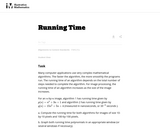
Students apply the remainder theorem and understand the role zeros play in the theorem.
- Subject:
- Mathematics
- Material Type:
- Lesson Plan
- Provider:
- EngageNY
- Date Added:
- 01/31/2018

Students apply the remainder theorem and understand the role zeros play in the theorem.

Practice using the Remainder Theorem.

This power point Explains the Remainder and Factor Theorems

This lesson unit is intended to help you assess how well students are able to translate between graphs and algebraic representations of polynomials. In particular, this unit aims to help you identify and assist students who have difficulties:
• Recognizing the connection between the zeros of polynomials when suitable
factorizations are available and graphs of the functions are defined by polynomials.
• Recognizing the connection between transformations of the graphs and transformations of the functions obtained by replacing f(x) by f(x + k), f(x) + k, -f(x), f(-x).

Interactive tool to see how the domains of trig functions need to be restricted for an inverse to exist.

This video discusses how to restrict domains of functions to make them invertible.

In this Khan Academy activity, students will rewrite exponential expressions.

In this video, students rewrite exponential expressions to prove they are equivalent.

Lesson which introduces students to right triangle trigonometry without using the unit circle. Knowledge of special triangles and angle relationships is necessary

This video solves a modeling problem that requires a trig function.

This PPT covers real and imaginary solutions of polynomials and how to use the Fundamental Theorem of Algebra

In this Khan Academy activity, students will rotate 2D shapes about a line and determine what 3D shape is produced.

End behavior of polynomials (with technology).

Students practice taking simple random samples, stratified random samples, systematic random samples, and cluster random samples in an archaeological setting. Additionally, students compare the performance of simple random sampling and stratified random sampling within the context of a specific archaeological problem.

The purpose of this task is to understand the process of making inferences about a population based on a random sample from that population.

Although margin of error can be computed by formula, this task is intended to engage students in considering how it can be estimated from examining the results of repeated simple random sampling.

The shifting of a function to the left or right on a graph is shown in this lesson.

The upwards or downwards of a function on a graph is shown in this lesson.

This task provides a geometric context for working with ratios and algebraic equations. Students will create and then solve an algebraic equation describing a remarkable shape, the silver rectangle.

This video shows that the sine of any angle is equal to the cosine of its complementary angle.